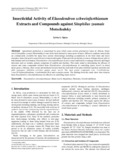| dc.contributor.author | Opiyo, Sylvia A. | |
| dc.date.accessioned | 2020-11-16T09:43:46Z | |
| dc.date.available | 2020-11-16T09:43:46Z | |
| dc.date.issued | 2020-11 | |
| dc.identifier.citation | American Journal of Chemistry 2020, 10(3): 39-44 | en_US |
| dc.identifier.uri | http://hdl.handle.net/123456789/4452 | |
| dc.description.abstract | Agricultural production is constrained by pests which cause serious post-harvest losses in African. Maize weevil (Sitophilus zeamais Motschulsky) is one of the most destructive insect pests of maize. Effective synthetic insecticides are commercially available but many have serious shortcomings including accumulation in the food chain and insect resistance, hence the need to search for novel insecticidal agents. Plants provide an alternative source of drugs that are safer to both humans and environment. Elaeodendron schweinfurthianum (Loes) is used traditionally to manage bacterial and fungal infections such as wounds, primary symptoms of syphilis and diarrhea. This study aimed at determining the efficacy of extracts and some compounds isolated from Elaeodendron schweinfurthianum in controlling maize weevil in stored maize grain. n-Hexane, ethyl acetate and methanol extracts from the stem bark of the plant exhibited repellent, mortality and adult emergence inhibition activities against maize weevil. The most potent compounds were 3-oxofriedelane, 3-oxo-29-hydroxyfriedelane, 3-oxofriedelan-28-al and α-amyrin acetate. The findings from this study show that extractes from Elaeodendron schweinfurthianum are effective in controlling maize weevil. | en_US |
| dc.language.iso | en | en_US |
| dc.subject | Elaeodendron schweinfurthianum | en_US |
| dc.subject | Maize weevil | en_US |
| dc.subject | Repellence | en_US |
| dc.subject | Mortality | en_US |
| dc.subject | Growth inhibition | en_US |
| dc.title | Insecticidal Activity of Elaeodendron schweinfurthianum Extracts and Compounds against Sitophilus zeamais Motschulsky | en_US |
| dc.type | Article | en_US |

